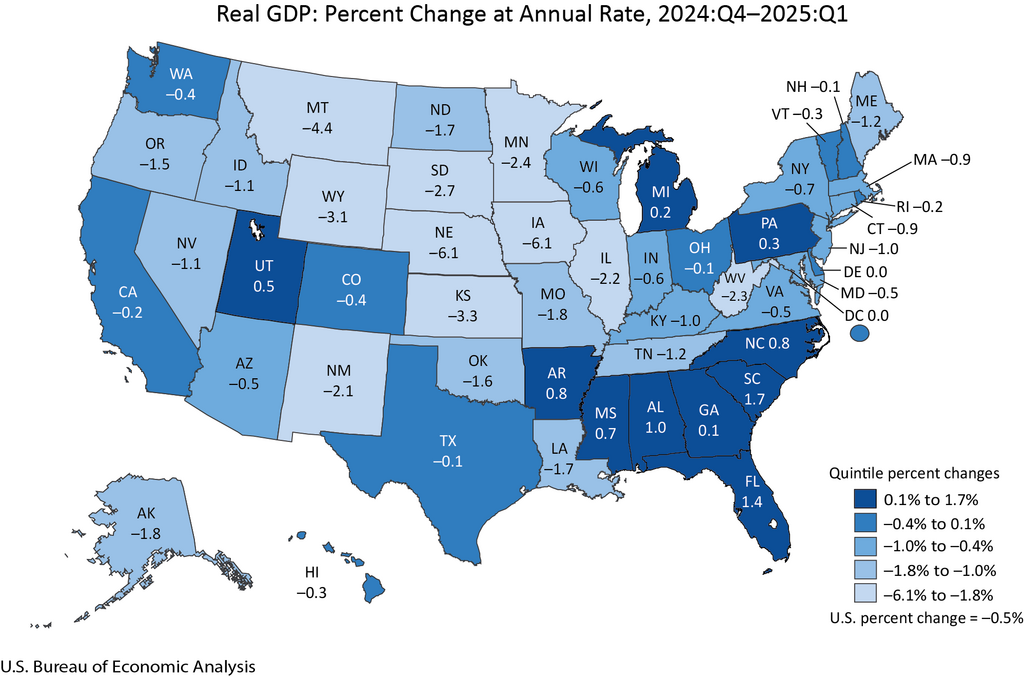Gross Domestic Product by State and Personal Income by State, 1st Quarter 2025 – Bureau of Economic Analysis (BEA) (.gov)

North Dakota Leads U.S. in Economic Growth: A Sustainable Development Perspective
Overview of Economic Performance
Recent data from the U.S. Bureau of Economic Analysis (BEA) highlights North Dakota as the national leader in earnings and gross domestic product (GDP) growth during the first quarter of 2023. This economic surge reflects the state’s effective policies promoting investment, innovation, and business expansion.
Key Economic Indicators
- Real GDP Growth: North Dakota experienced a 12.4% increase in real GDP over the past year, the highest among all 50 states, surpassing the national average growth of 2% by more than six times.
- Earnings Growth: Earnings in North Dakota rose at an annualized rate of 12.4% in Q1 2023, nearly triple the nationwide rate of 4.6%.
- Personal Income: Personal income increased at an annualized rate of 11%, ranking third nationally behind Maine (11.4%) and Nebraska (11.1%).
Contributions to Economic Growth
- Agriculture, Forestry, Fishing, and Hunting: These sectors increased in 33 states and were the leading contributors to real GDP growth in 13 states, including North Dakota. The five states with the largest increases were North Dakota, Nebraska, South Dakota, Kansas, and Montana.
- Farm Earnings: Growth in farm earnings was a primary driver of personal income increases in four of the five fastest-growing states: Nebraska, North Dakota, Iowa, and South Dakota.
- Oil, Gas Extraction, and Mining: North Dakota led all states in increases in personal income and real GDP attributed to these sectors.
Economic Development and Workforce Growth
State Commerce Commissioner Josh Teigen emphasized that North Dakota’s explosive growth in new project investment has resulted in significant wage increases and job creation. The state has attracted a growing workforce drawn by higher-paying employment opportunities, illustrating the positive feedback loop between economic and workforce development.
Alignment with Sustainable Development Goals (SDGs)
- SDG 8 – Decent Work and Economic Growth: North Dakota’s robust GDP and earnings growth demonstrate progress toward sustained, inclusive economic growth and productive employment for all citizens.
- SDG 9 – Industry, Innovation, and Infrastructure: The state’s focus on innovation over regulation supports resilient infrastructure and fosters innovation, critical for long-term economic sustainability.
- SDG 2 – Zero Hunger: The leading role of agriculture and farm earnings in economic growth highlights contributions to sustainable agriculture and food security.
- SDG 10 – Reduced Inequalities: Increased personal income and job creation contribute to reducing income disparities within the state.
Conclusion
North Dakota’s economic achievements in early 2023 underscore the effectiveness of policies fostering innovation, investment, and business growth. These developments not only enhance the state’s prosperity but also contribute to multiple Sustainable Development Goals, positioning North Dakota as a model for sustainable and inclusive economic development.
For further details, the full BEA report is available here.
1. Sustainable Development Goals (SDGs) Addressed or Connected to the Issues Highlighted in the Article
-
SDG 8: Decent Work and Economic Growth
- The article emphasizes North Dakota’s strong economic growth, increased earnings, and personal income, which are directly related to promoting sustained, inclusive, and sustainable economic growth and productive employment.
- References to business expansion, innovation, and workforce development align with the goal of promoting productive employment and decent work for all.
-
SDG 9: Industry, Innovation, and Infrastructure
- The focus on innovation over regulation and investment in new projects supports the development of resilient infrastructure, promotion of inclusive and sustainable industrialization, and fostering innovation.
-
SDG 2: Zero Hunger (Agriculture)
- The article highlights growth in agriculture, forestry, fishing, and hunting, which are crucial for sustainable agriculture and food security.
-
SDG 7: Affordable and Clean Energy
- Mentions of oil and gas extraction and mining relate to energy production, which is relevant to ensuring access to affordable, reliable, sustainable, and modern energy.
2. Specific Targets Under Those SDGs Identified Based on the Article’s Content
-
SDG 8 Targets
- Target 8.1: Sustain per capita economic growth in accordance with national circumstances.
- Target 8.2: Achieve higher levels of economic productivity through diversification, technological upgrading, and innovation.
- Target 8.5: Achieve full and productive employment and decent work for all women and men.
-
SDG 9 Targets
- Target 9.2: Promote inclusive and sustainable industrialization and, by 2030, significantly raise industry’s share of employment and GDP.
- Target 9.5: Enhance scientific research, upgrade technological capabilities of industrial sectors.
-
SDG 2 Targets
- Target 2.3: Double the agricultural productivity and incomes of small-scale food producers.
-
SDG 7 Targets
- Target 7.1: Ensure universal access to affordable, reliable, and modern energy services.
3. Indicators Mentioned or Implied in the Article to Measure Progress Towards the Identified Targets
-
Economic Growth and Productivity Indicators
- Real Gross Domestic Product (GDP) growth rate (e.g., North Dakota’s 12.4% growth in real GDP).
- Annualized rate of earnings growth (e.g., 12.4% increase in earnings).
- Personal income growth rate (e.g., 11% increase in personal income).
-
Employment and Workforce Development Indicators
- Growth in wages and new employee numbers as a measure of workforce development.
- Inflow of workers attracted by higher-paying jobs.
-
Agricultural Productivity Indicators
- Growth in agriculture, forestry, fishing, and hunting sectors contributing to GDP growth.
- Farm earnings increases contributing to personal income growth.
-
Industrial and Energy Production Indicators
- Contribution of oil and gas extraction and mining to personal income and GDP growth.
- Investment in new projects indicating industrial expansion and innovation.
4. Table of SDGs, Targets, and Indicators
| SDGs | Targets | Indicators |
|---|---|---|
| SDG 8: Decent Work and Economic Growth |
|
|
| SDG 9: Industry, Innovation, and Infrastructure |
|
|
| SDG 2: Zero Hunger |
|
|
| SDG 7: Affordable and Clean Energy |
|
|
Source: governor.nd.gov








